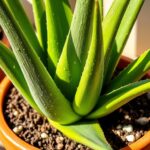I love plants, and aloe vera is one of my favorites. They live well in dry places, with thick leaves that handle harsh conditions. But what if we put them in a wet place? Can they still do well, or will they get too wet?
I’ve always wondered about this. As I learn more about aloe vera, I see how they handle different environments. Let’s find out how aloe vera deals with lots of moisture and how to help them stay healthy.
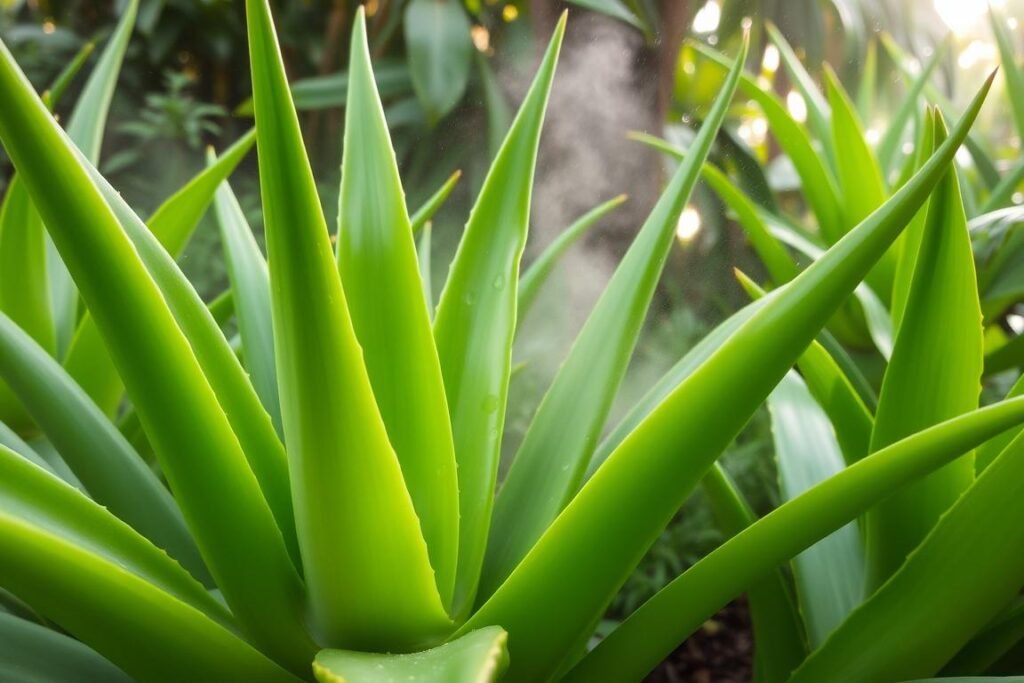
Key Takeaways
- Aloe vera plants prefer a humidity range of 40-50% to thrive.
- Excessive humidity can lead to waterlogged roots and potential rot in aloe vera plants.
- Aloe vera’s transpiration and water uptake mechanisms are impacted by high humidity levels.
- Aloe vera is not well-suited for high humidity environments, as it can result in diseases and structural issues.
- Proper humidity management is crucial for maintaining healthy aloe vera plants, even when grown indoors.
Understanding Aloe Vera’s Natural Habitat and Origins
Aloe vera grows in the dry lands of the Arabian Peninsula. It loves the hot, dry weather. This helps it grow well, even in places with lots of moisture.
Desert Climate Adaptations
Aloe vera can handle very hot and very cold temperatures. Its thick leaves and stems store water. This helps it survive long without water.
Native Growing Conditions
Aloe vera likes sandy soil that drains well. It prefers soil that’s not too acidic or too alkaline. The dry air helps it grow strong.
Temperature Fluctuations in Natural Environment
The temperature changes a lot where aloe vera grows. It gets very hot during the day and very cold at night. This makes it very strong.
“Aloe vera’s natural habitat is characterized by extreme temperatures, minimal humidity, and well-draining, sandy soil – a true testament to its adaptability and resilience.
Knowing where aloe vera comes from helps us grow it better. It can thrive in many places, even where it’s humid.
Can Aloe Vera Plants Tolerate High Humidity
Aloe vera plants are tough and can adapt to many conditions. But, they don’t like too much humidity. They do best in dry places, not wet ones.
These plants need air that’s not too wet. They like it when the air is between 40-50% humid. If it’s too humid, they can get sick.
Aloe vera plants have a special way to use water. They need dry air to work well. But, in wet air, they can’t use water right and get sick.
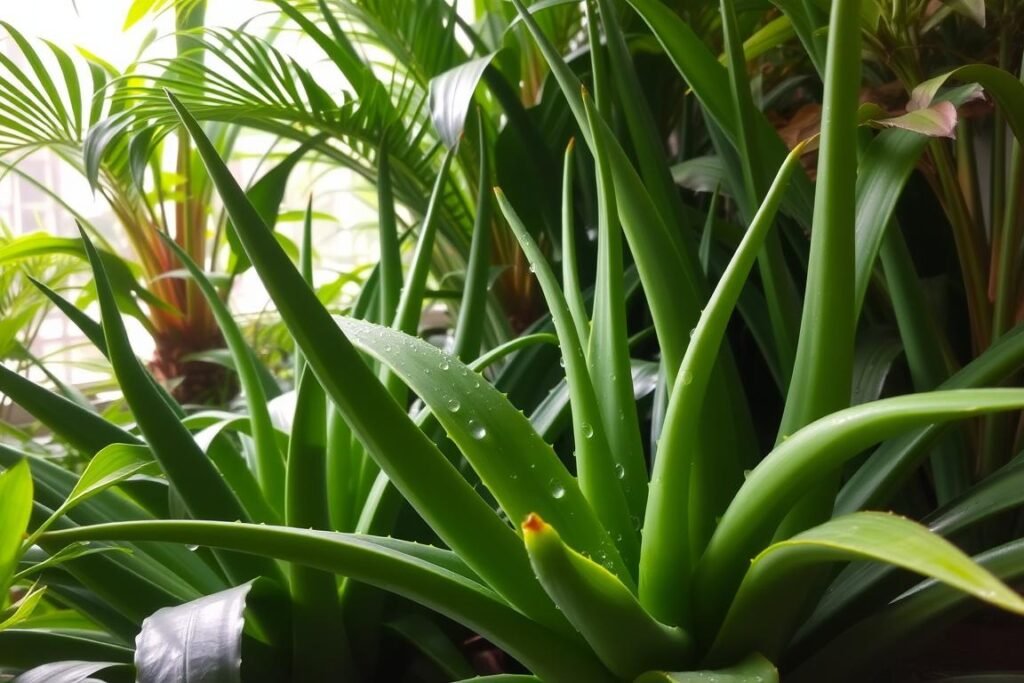
Even though aloe vera plants can handle different conditions, they prefer dry air. In wet places, they need good air flow and careful water use. People taking care of aloe vera plants must watch the humidity and adjust how they care for them.
The Impact of Humidity on Aloe Vera Growth
Aloe vera is a favorite succulent that needs the right environment. But, it’s very sensitive to humidity. Humidity affects its growth, water use, and health a lot.
Transpiration Process in Humid Conditions
In humid places, aloe vera’s water release is blocked. This stops it from getting the water it needs. It can cause roots to get too wet and hurt the plant’s health.
Water Uptake Mechanisms
Aloe vera loves dry places and stores water inside. In wet conditions, it takes less water from the soil. This makes its leaves soft and sometimes change color.
Signs of Humidity Stress
High humidity can stress aloe vera plants. They might have soft leaves, yellow spots, and get sick more easily. The plant can’t release water well in wet air, leading to health problems and slow growth.
Knowing how humidity affects aloe vera is key to growing it well. By watching humidity and adjusting it, you can help your aloe vera plant stay healthy and strong.
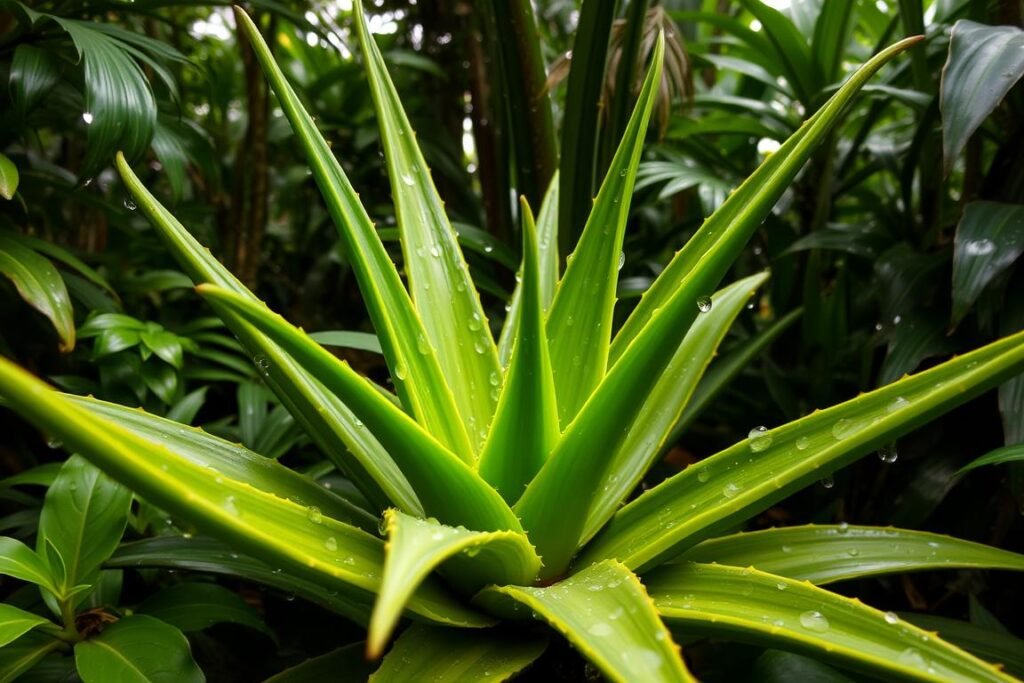
Optimal Humidity Levels for Healthy Aloe Plants
Keeping the right humidity is key for aloe vera plants to stay healthy. The best humidity for them is between 40-50%. This helps them breathe and drink water well without getting too wet.
Aloe vera plants do okay with a bit of extra moisture. But they love it when it’s drier. Keeping the humidity just right helps them avoid getting too dry or too wet. This keeps them looking their best.
- Aloe vera plants prefer a relative humidity of around 40%.
- Maintaining ideal humidity levels between 40% and 50% is recommended for optimal aloe vera growth.
- Excess moisture in the air can harm aloe vera plants, promoting fungal growth and root rot.
- High humidity levels exceeding 50% can create conditions too moist for aloe vera, potentially leading to root rot or fungal issues.
Knowing the optimal humidity requirements for aloe vera plants helps them grow well. Watching and adjusting the humidity is important. It keeps your aloe vera plants happy and healthy for a long time.
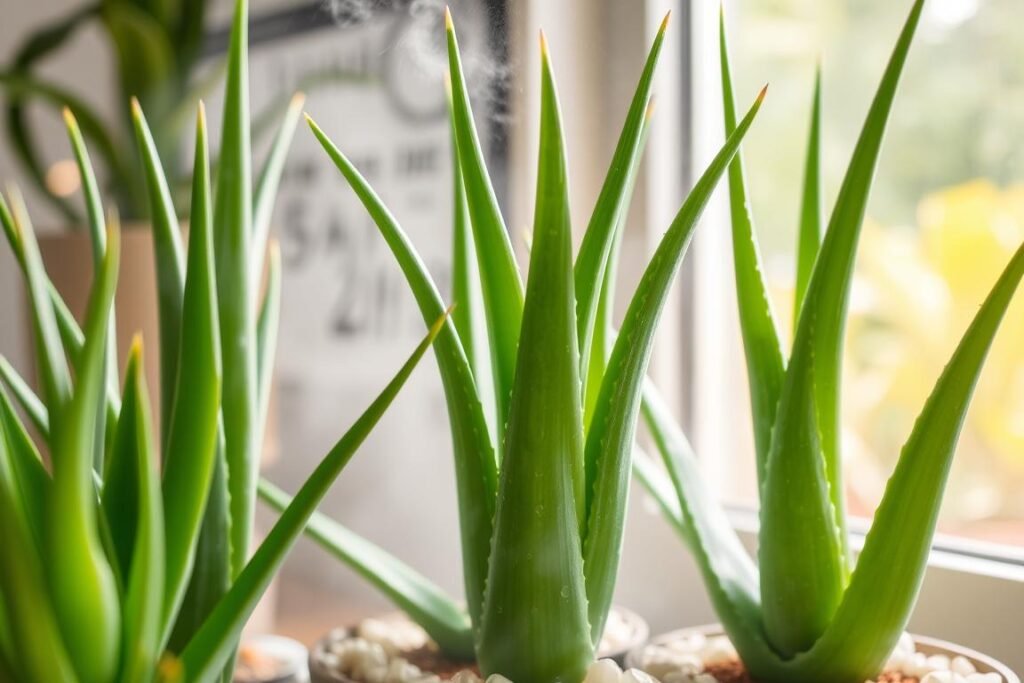
“Aloe vera plants thrive best in environments with humidity levels ranging from 30% to 50%, considered average humidity.”
Common Problems Caused by Excessive Humidity
Aloe vera plants are usually very hardy. But, too much humidity can cause problems. They like dry air, not wet.
Root Rot and Fungal Issues
Too much moisture can cause root rot. Aloe vera care in high humidity needs careful watching. Fungi can harm the roots in wet air.
Root rot shows as mushy, colored roots and a bad smell. This happens when you pull the plant out.
Leaf Problems and Diseases
High humidity also hurts the leaves. They might turn soft, yellow, or get brown spots. Fungal diseases like rust can also harm the leaves in wet air.
Structural Weakness
Too much wet air can make the plant weak. It becomes easy for pests and diseases to attack. The plant’s health and look can suffer.
To avoid these issues, make sure your aloe vera has good drainage and air flow. Keeping the right humidity and growing conditions is key for a healthy plant.
Temperature and Humidity Relationship
Aloe vera plants need the right temperature and humidity to grow well. They like temperatures between 50°F and 85°F. The best is in the 70s to 80s Fahrenheit.
But, temperature and humidity don’t work together in a simple way. Warmer temperatures let aloe vera handle more humidity. Cooler temperatures need less humidity to avoid problems like root rot.
Aloe ‘Krakatoa’ likes humidity between 40% and 60%. Dry air makes leaves crispy or brown. Too much moisture turns leaves yellow or makes the base soft. Using a hygrometer to check humidity is a good idea.
| Humidity Levels | Aloe Vera Response |
|---|---|
| 40-60% Relative Humidity | Ideal growth conditions |
| Below 40% Relative Humidity | Dry air, crispy leaves, browning edges |
| Above 60% Relative Humidity | Excessive moisture, yellowing leaves, soft base |
Knowing how temperature and humidity work together helps aloe vera plants grow well. This balance is key for their health and long life, indoors or in humid places.
“Monitoring humidity levels using a hygrometer helps prevent moisture-related plant issues.”
Managing Humidity Levels for Indoor Aloe Plants
Keeping aloe vera plants healthy indoors means watching humidity levels. Aloe vera can handle average home humidity. But, finding the right balance is key for growth and health.
Ventilation Strategies
Good air flow is crucial for aloe vera plants indoors. Open windows or use fans to improve air circulation. This stops humid air from building up and causing problems like root rot or fungal diseases.
Dehumidification Methods
If your room is too humid, a dehumidifier can help. Aloe vera plants do best in humidity between 30-50%. Keeping humidity in check helps your aloe vera grow well.
Placement Considerations
Don’t put aloe vera plants in humid places like bathrooms or kitchens. Instead, place them where air flows well. Also, don’t group them with plants that love humidity too much.
To add a bit of moisture in dry places, use pebble trays with water. This helps create a better environment. Also, watch how your heating and cooling systems affect humidity in your home.
By using these methods, you can make sure your indoor aloe vera plants get the best conditions for growing aloe vera indoors. They will do great in your home.
Best Practices for Growing Aloe in Humid Climates
Growing aloe vera in humid places needs careful steps. You can make your aloe happy with the right care. Focus on good soil, right watering, and enough light.
First, pick a potting mix made for cacti and succulents. Aloe vera hates wet roots, so let the soil dry out. Water only when it’s dry.
Light is key for aloe in humid areas. Give them 6 hours of sun a day. If it’s very humid, use a fan or dehumidifier. This helps air move and keeps plants healthy.
- Use well-draining soil and pots with drainage holes to prevent root rot.
- Water sparingly, allowing the soil to dry completely between waterings.
- Provide bright, direct sunlight for at least 6 hours per day.
- Implement good air circulation around the plant using a fan or dehumidifier.
- Monitor the plant regularly for signs of humidity stress and adjust care according.
Follow these tips for growing aloe in humid places. Your plants will stay bright and healthy, even in tough conditions.
Seasonal Humidity Variations and Care Adjustments
I love taking care of my aloe vera plants. I change how I care for them with the seasons. In summer, when it’s humid, I water them less. I also make sure they get lots of air to avoid root rot and diseases.
In winter, the air gets dry because of the heat. Aloe vera plants like the air to be between 30-50% humid. I use a hygrometer to check the humidity. If it’s too dry, I might use a humidifier or group my plants together.
Changing how often I water is key. I check if the soil is dry before watering. This way, my plants get the right amount of water all year.
FAQ
Can aloe vera plants tolerate high humidity?
Aloe vera plants like dry air, not wet. They do okay with some humidity. But they’re best when the air is between 40-50% humid.
What are the effects of high humidity on aloe vera plants?
Too much water can hurt aloe vera plants. It makes their roots soggy and can cause fungus. This messes up how they get water and nutrients.
What is the ideal humidity level for growing healthy aloe vera plants?
Aloe vera plants do best in air that’s 40-50% humid. This helps them breathe and get water right. Keeping the air just right is key for their health.
What are the common problems caused by excessive humidity for aloe vera?
Too much water can rot aloe vera roots and cause fungus. It also harms their leaves. This weakens the plant and makes it sick.
How does temperature affect the humidity requirements for aloe vera plants?
Temperature and humidity go together for aloe vera. Warmer air lets them handle more humidity. Cooler air needs less. Finding the right mix is important, even indoors.
How can I manage humidity levels for my indoor aloe vera plants?
To control humidity indoors, make sure air moves well. Use dehumidifiers if it’s too wet. Place plants where air flows freely. Don’t group them with plants that like wet air. Use a pebble tray to add a bit of moisture in dry spots.
What are the best practices for growing aloe vera in humid climates?
In wet places, use soil that drains well and pots with holes. Water carefully and give them lots of sunlight. Make sure air moves around them. Use a fan or dehumidifier if it’s very wet. Watch your plant for signs of too much moisture.
How should I adjust aloe vera care based on seasonal humidity changes?
Change how you care for aloe vera with the seasons. In summer, water less and keep air moving. In winter, when it’s dry, check humidity and water more if needed. Water based on how dry the soil is, not just by schedule.






